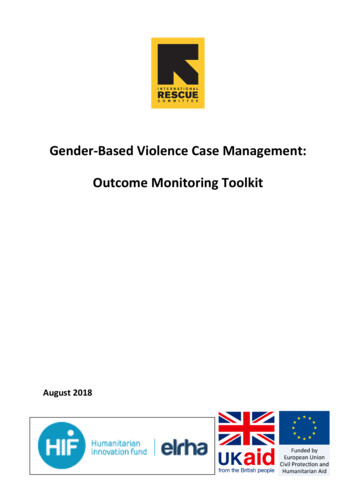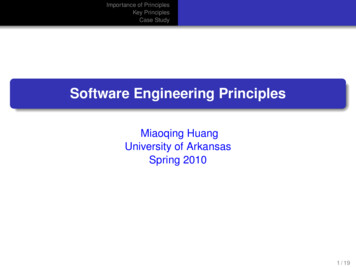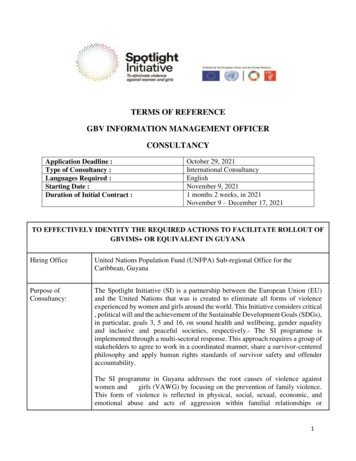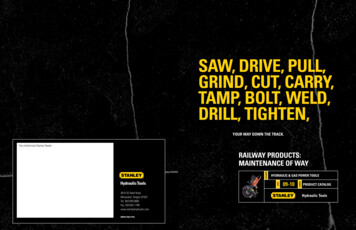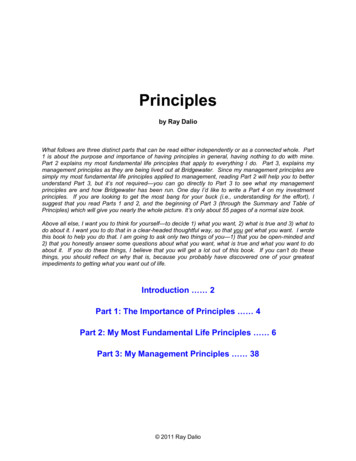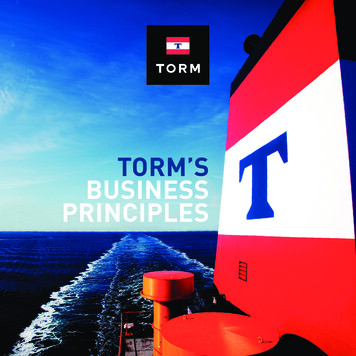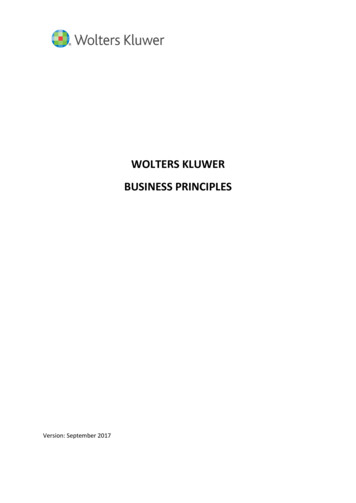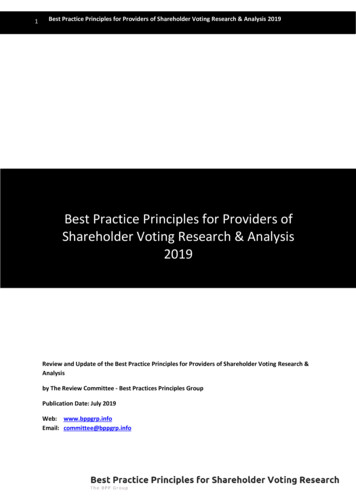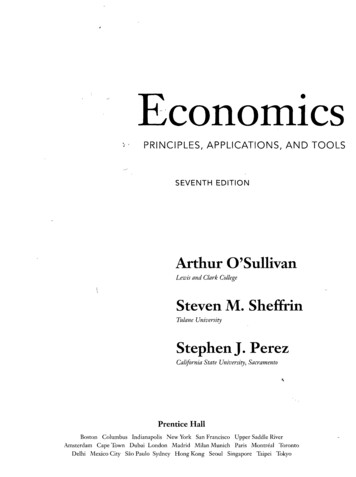
Transcription
EconomicsPRINCIPLES, APPLICATIONS, AND TOOLSSEVENTH EDITIONArthur O'SullivanLewis and Clark CollegeSteven M. SheffrinTulane UniversityStephen J. PerezCalifornia State University, SacramentoPrentice HallBoston Columbus Indianapolis New York San Francisco Upper Saddle RiverAmsterdam Cape Town Dubai London Madrid Milan Munich Paris Montreal TorontoDelhi Mexico City Sao Paulo Sydney Hong Kong Seoul Singapore Taipei Tokyo
Brief ContentsPART 1Introduction and Key PrinciplesPART 7The International Economy1Introduction: What Is Economics? 118International Trade and Public Policy 3642The Key Principles of Economics 2819The World of International Finance 3853Exchange and Markets 494Demand, Supply, and MarketEquilibrium 6520Elasticity: A Measure ofResponsiveness 409The Basic Concepts in Macroeconomics21Measuring a Nation's Production andIncome 97Market Efficiency and GovernmentIntervention 43 722Consumer Choice Using UtilityTheory 462PART 256PART 3PART 8Unemployment and Inflation120A Closer Look at Demand and SupplyPART 9 Market Structures and PricingThe Economy in the Long Run23Production Technology and Cost 49324Perfect Competition25Monopoly and Price Discrimination26Aggregate Demand and AggregateSupply 185Market Entry and MonopolisticCompetition 55827Oligopoly and Strategic Behavior 57410Fiscal Policy 2052811The Income-Expenditure Model 223Controlling Market Power: Antitrust andRegulation 60112Investment and Financial Markets 2537The Economy at Full Employment8Why Do Economies Grow?PART 49PART 5158Economic Fluctuations and Fiscal PolicyMoney, Banking, and Monetary Policy13Money and the Banking System 27214The Federal Reserve and MonetaryPolicy 291PART 6139Inflation, Unemployment, and EconomicPolicy514538PART 10 Externalities and Information29Imperfect' Information: Adverse Selectionand Moral Hazard 61730Public Goods and Public Choice 64331External Costs and EnvironmentalPolicy 660PART 11 The Labor Market and IncomeDistribution15Modern Macroeconomics: From the ShortRun to the Long Run 3113216The Dynamics of Inflation andUnemployment 329The Labor Market, Income, andPoverty 6813317Macroeconomic Policy Debates 347Unions, Monopsony, and ImperfectInformation 705XI
ContentsPreview of Coming Attractions:"Macroeconomics 11Preface xxxivPART 1 Introduction and KeyPrinciplesUsing Macroeconomics to Understand WhyEconomies Grow 111 Introduction: What Is Economics?Using Macroeconomics to Understand EconomicFluctuations 11What Is Economics?21Using Macroeconomics to Make InformedBusiness Decisions 12 .fPositive versus Normative Analysis 3The Three Key Economic Questions: What, How,and Who? 4Economic Models 4Economic Analysis and Modern ProblemsEconomic View of Traffic Congestion 5Economic View of Poverty in Africa 5Economic View of the Current WorldRecession 6The Economic Way of Thinking75Preview of Coming Attractions:Microeconomics 12Using Microeconomics to Understand Marketsand Predict Changes 12Using Microeconomics to Make Personal andManagerial Decisions 12Using Microeconomics to Evaluate PublicPolicies 13* SUMMARY 13 * KEY TERMS 13* EXERCISES 13Use Assumptions to Simplify 7APPENDIX A: Using Graphs andPercentages 15Isolate Variables—Ceteris Paribus 7USING GRAPHSThink at the Margin 8COMPUTING PERCENTAGE CHANGES AND USINGEQUATIONS 2315Rational People Respond to Incentives 8APPLICATION 1 Responding to ProductionRewards 9Example: London Addresses its CongestionProblem 9APPLICATION 2 The Economic Solution toSpam 10APPLICATION 3 The Perils ofPercentages 242 The Key Principles of Economics 28The Principle of Opportunity Cost29The Cost of College 29XIII
The Cost of Military Spending 30Comparative Advantage versus AbsoluteAdvantage 52Opportunity Cost and the Production PossibilitiesCurve 31APPLICATION 1 Don't Forget the Costs ofTime and Invested Funds 32The Division of Labor and Exchange 52Comparative Advantage and InternationalTrade 53Outsourcing 53The Marginal Principle 332How Many Movie Sequels? 34APPLICATION 1 Candy Cane Makers Move toMexico for Cheap Sugar 54Renting College Facilities 3 5MarketsAutomobile Emissions Standards 36Virtues of Markets 55APPLICATION 2 Why Not Walk up anEscalator? 36The Role of Entrepreneurs 56Driving Speed and Safety 37The Principle of Voluntary ExchangeAPPLICATION 2 Gold Farming for World ofWarcraft 5737Example of the Emergence of Markets: POWCamps 57Exchange and Markets 3 7APPLICATIONS Jasper Johns andHousepainting 38APPLICATION 3 The Shakers and the Marketfor Garden Seeds 58Online Games and Market Exchange 38The Principle of Diminishing ReturnsMarket Failure and the Role ofGovernment 5839Government Enforces the Rules of Exchange 59APPLICATION 4 Fertilizer and CropYields 39Diminishing Returns from Sharing a ProductionFacility 40The Real-Nominal Principle5540APPLICATION 5 The Declining Real MinimumWage 41APPLICATION 6 Repaying Student Loans 42Government Can Reduce EconomicUncertainty 60* SUMMARY 60 * KEY TERMS 61* EXERCISES 614 Demand, Supply, and MarketEquilibrium 65The Demand Curve* SUMMARY 43 * KEY TERMS 43* EXERCISES 43* ECONOMIC EXPERIMENT 4766The Individual Demand Curve and the Law ofDemand 66From Individual Demand to Market Demand 683 Exchange and Markets 49The Supply Curve 69Comparative Advantage and ExchangeSpecialization and the Gains from Trade 5050The Individual Supply Curve and the Law ofSupply 69
XVWhy Is the Individual Supply Curve PositivelySloped? 71APPLICATION 3 The Supply and Demand forCruise Ship Berths 88From Individual Supply tq Market Supply 71APPLICATION 4 The Bouncing Price of VanillaBeans 89Why Is the Market Supply Curve PositivelySloped? 73APPLICATION 5 Drought in Australia and the'Price of Rice 90Market Equilibrium: Bringing Demand andSupply Together 73* SUMMARY 91 * KEY TERMS 91* EXERCISES 91* ECONOMIC EXPERIMENT 95Excess Demand Causes the Price to Rise 74Excess Supply Causes the Price to Drop 75Market Effects of Changes in Demand75Change in Quantity Demanded versus Change in fDemand 75Increases in Demand Shift the DemandCurve 76A Decrease in Demand Decreases the EquilibriumPrice 7979Change in Quantity Supplied versus Change inSupply 79The Production Approach: Measuring aNation's Macroeconomic Activity Using GrossDomestic Product 100Putting It All Together: The GDP EquationAn Increase in Supply Decreases the EquilibriumPrice 82Decreases in Supply Shift the Supply Curve 83Measuring National Income through ValueAdded 107Simultaneous Changes in Demand andSupply 848686APPLICATION 1 Hurricane Katrina and BatonRouge Housing Prices 87APPLICATION 2 Honeybees and the Price ofIce Cream 87105The Income Approach: Measuring a Nation'sMacroeconomic Activity Using NationalIncome 105Measuring National Income 105A Decrease in Supply Increases the EquilibriumPrice 83Predicting and Explaining Market ChangesThe Circular Flow of Production and Income 99The Components of GDP 102Increases in Supply Shift the Supply Curve 81Applications of Demand and Supply5 Measuring a Nation's Production andIncome 97The "Flip" Sides of Macroeconomic Activity:Production and Income 98Decreases in Demand Shift the DemandCurve 78Market Effects of Changes in SupplyPART 2 The Basic Concepts inMacroeconomics-APPLICATION 1 Using Value Added toMeasure the True Size of Wal-Mart 107An Expanded Circular Flow 108A Closer Examination of Nominal and RealGDP 108Measuring Real versus Nominal GDPHow to Use the GDP Deflator110109
XVIFluctuations in GDP 111InflationAPPLICATION 2 Comparing the Severity ofRecessions 112GDP as a Measure of Welfare113Shortcomings of GDP as a Measure of Welfare 113APPLICATION 3 The Links Between SelfReported Happiness and'GDP 114* SUMMARY 115 *KEYTERMS 115* EXERCISES 116132Historical U.S. Inflation Rates 133The Perils of DeflationThe Costs of Inflation13 3134Anticipated Inflation 134Unanticipated Inflation 135* SUMMARY 136 * KEY TERMS 136* EXERCISES 1366 Unemployment and Inflation 120Examining UnemploymentV '121How Is Unemployment Denned andMeasured? 121Alternative Measures of Unemployment and WhyThey Are Important 122APPLICATION 1 After Growing Sharply,Women's Labor Force Participation hasLeveled Off 123Who Are the Unemployed? 124APPLICATION 2 More Disability, LessUnemployment? 125Categories of Unemployment126Types of Unemployment:, Cyclical, Frictional, andStructural 126The Natural Rate of Unemployment 127The Costs of Unemployment 128APPLICATION 3 Social Norms, Unemployment,and Perceived Happiness 129The Consumer Price Index and the Cost ofLiving 129The CPI versus the Chain Index for GDP 130Problems in Measuring Changes in Prices 131APPLICATION 4 The Introduction of CellPhones and the Bias in the CPI 132PART 3 The Economy in theLong Run7 The Economy at Full Employment 139Wage and Price Flexibility and FullEmployment -140The Production Function140Wages and the Demand and Supply forLabor 143Labor Market Equilibrium 143Changes in Demand and Supply 144APPLICATION 1 The Black Death and LivingStandards in Old England 145Labor Market Equilibrium and FullEmployment 145Using the Full-Employment ModelTaxes and Potential Output 147Real Business Cycle Theory 148APPLICATION 2 A Nobel LaureateExplains Why Europeans WorkLess Than U.S. Workers or-iheJapanese 149APPLICATION 3 Can Labor MarketPolicies Account for the GreatDepression? 151147
XVIIDividing Output among Competing Demandsfor GDP at Full Employment 151International Comparisons 152Education, Human Capital, and the Accumulationof Knowledge 172Crowding Out in an Open Economy 153154* SUMMARY 155 *KEYTERMS* EXERCISES 1558 Why Do Economies Grow?Economic Growth RatesAPPLICATION 5 The Role of Political Factorsin Economic Growth 173155APPLICATION 6 Culture, Evolution, andEconomic Growth 174158New Growth Theory 174159,Measuring Economic GrowthA Key Governmental Role: Providing theCorrect Incentives and Property Rights 175160APPLICATION 7 Lack of Property RightsHinders Growth in Peru 176Comparing the Growth Rates of VariousCountries 161* SUMMARY 177 *KEYTERMS* EXERCISES 177APPLICATION 1 Global Warming, RichCountries, and Poor Countries 162Are Poor Countries Catching Up? 163APPLICATION 2 Growth Need Not CauseIncreased Inequality 164Capital Deepening164Saving and InvestmentThe Scale of the Market 172Induced Innovations 172Crowding Out in a Closed Economy 152Crowding InMonopolies That Spur Innovation 172177APPENDIX A: A Model of CapitalDeepening 180PART 4 Economic Fluctuations andFiscal Policy165How Do Population Growth, Government, andTrade Affect Capital Deepening? 166The Key Role of Technological Progress168How Do We Measure Technological Progress?168APPLICATION 3 Sources of Growth in Chinaand India 169Using Growth Accounting 1709 Aggregate Demand and AggregateSupply 185Sticky Prices and Their MacroeconomicConsequences 186Flexible and Sticky Prices 186How Demand Determines Output in the ShortRun 187APPLICATION 4 Growth Accounting andInformation Technology 170APPLICATION 1 Measuring Price Stickiness inConsumer Markets 188What Causes Technological Progress?Understanding Aggregate DemandResearch and Development Funding171171188What Is the Aggregate Demand Curve? 188
XVIIIThe Components of Aggregate Demand189Why the Aggregate Demand Curve SlopesDownward 189Are Deficits Bad? 215Fiscal Policy in U.S. HistoryShifts in the Aggregate Demand Curve 190195The Kennedy Administration 217The Vietnam War Era 217The Long-Run Aggregate Supply Curve 195The Short-Run Aggregate Supply Curve216The Depression Era 216How the Multiplier Makes the Shift Bigger 192Understanding Aggregate SupplyAutomatic Stabilizers 215196 -- APPLICATION 2 Two Approachesto Determining the Causes ofRecessions 198The Reagan Administration 218The Clinton and George W. Bush Administrations218APPLICATION 3 Evaluating the Obama FiscalStimulus 219V*APPLICATION 3 How the U.S. Economy HasCoped with Oil Price Fluctuations l 199* SUMMARY 220 * KEY TERMS 220* EXERCISES 221Supply Shocks 199From the Short Run to the Long Run200Looking Ahead 20111 The Income-Expenditure Model 223A Simple Income-Expenditure Model* SUMMARY 202 * KEY TERMS 202* EXERCISES 202224Equilibrium Output 224Adjusting to Equilibrium Output 22510 Fiscal Policy 205The Consumption FunctionThe Role of Fiscal PolicyConsumer Spending and Income 227206Changes in the Consumption Function 227Fiscal Policy and Aggregate Demand 206APPLICATION 1 Falling Home Prices, the Wealth Effect, and Decreased ConsumerSpending 229The Fiscal Multiplier 207The Limits to Stabilization Policy 208The Federal BudgetEquilibrium Output and the ConsumptionFunction 229210Federal Spending 210APPLICATION 1 Increasing Life Expectancyand Aging Populations Spur Costs ofEntitlement Programs 212Federal Revenues 212APPLICATION 2 The Confucius Curve?The Federal Deficit and Fiscal Policy 214227214Saving and Investment 231Understanding the Multiplier 232APPLICATION 2 Using Long-Term MacroData to Measure Multipliers 233Government Spending and TaxationFiscal Multipliers 234234
XIXUsing Fiscal Multipliers 236APPLICATION 3 John Maynard Keynes: AWorld Intellectual 238Understanding Automatic Stabilizers 238APPLICATION 4 Securitization: The Good,the Bad, and the Ugly 267* SUMMARY 268 * KEY TERMS 268* EXERCISES 269* ECONOxVIIC EXPERIMENT 270Exports and Imports 241APPLICATION 4 The Locomotive Effect: HowForeign Demand Affects a Country'sOutput 242The Income-Expenditure Model and theAggregate Demand Curve 243* SUMMARY 245 * KEY TERMS 246* EXERCISES 246 '* ECONOMIC EXPERIMENT 248APPENDIX: Formulas for Equilibrium Incomeand the Multiplier 24912 Investment and Financial Markets 253PART 5 Money, Banking, andMonetary Policy1 3 Money and the Banking System 272What Is Money? 273Three Properties of Money 273Different Types of Monetary Systems 274Measuring Money in the U.S. Economy 275APPLICATION 1 City-Issued Money in theGreat Depression 276How Banks Create Money 277An Investment: A Plunge into theUnknown 254A Bank's Balance Sheet: Where the Money Comesfrom and Where It Goes 277APPLICATION 1 Energy Price UncertaintyReduces Investment Spending 255How Banks Create Money 278Evaluating the Future 256How the Money Multiplier Works 279APPLICATION 2 The Growth in ExcessReserves 280Understanding Present Value 256APPLICATION 2 Options for a LotteryWinner 258How the Money Multiplier Works inReverse 280Real and Nominal Interest Rates 258A Banker's Bank: The Federal ReserveUnderstanding Investment Decisions260Investment and the Stock Market 261How Financial Intermediaries FacilitateInvestment 263APPLICATION 3 Underwater Homes: BetsGone Wrong 265When Financial Intermediaries Malfunction 266281Functions of the Federal Reserve 281The Structure of the Federal Reserve 282The Independence of the Federal Reserve 283What the Federal Reserve Does During aFinancial Crisis 284APPLICATION 3 The Financial System UnderStress: September 11, 2001 284
XXAPPLICATION 4 Coping with the FinancialChaos Caused by the Mortgage Crisis 285* SUMMARY 286 * KEY TERMS 286* EXERCISES 286* ECONOMIC EXPERIMENT 288APPENDIX: Formula for Deposit Creation 2901 4 The Federal Reserve and MonetaryPolicy 291,* SUMMARY 307 * KEY TERMS 308* EXERCISES 308PART 6 Inflation, Unemployment,and Economic Policy1 5 Modern Macroeconomics: From theShort Run to the Long Run 311Linking the Short Run and theLong Run 312The Money Market 292The Demand for Money 292» 'How the Federal Reserve Can Change theMoney Supply 294Open Market Operations 295Other Tools of the Fed 295APPLICATION 1 Beyond Purchasing TreasurySecurities 296How Interest Rates are Determined:Combining the Demand and Supply ofMoney 297Interest Rates and Bond Prices 298APPLICATION 2 Rising Interest Rates Duringan Economic Recovery 300Interest Rates and How They ChangeInvestment and Output (GDP) 301Monetary Policy and International Trade 303The Difference between the Short andLong Run 312Wages and Prices and Their Adjustment overTime 312How Wage and Price Changes Move theEconomy Naturally Back to FullEmployment 313Returning to Full Employment from aRecession 314Returning to Full Employment from aBoom 315Economic Policy and the Speed ofAdjustment 315APPLICATION 1 Avoiding a LiquidityTrap 317Liquidity Traps 317Political Business Cycles 317Monetary Policy Challenges for the Fed 304APPLICATION 3 The Effectiveness ofCommittees 305Lags in Monetary Policy 305APPLICATION 2 Elections, Political Parties,and Voter Expectations 318Understanding the Economics of theAdjustment Process 318Influencing Market Expectations: From theFederal Funds Rate to Interest Rates on LongTerm Bonds 306The Long-Run Neutrality of Money 320Looking Ahead: From the Short Run to the LongRun 307APPLICATION 3 Increasing Health-CareExpenditures and Crowding Out 323Crowding Out in the Long Run 322
XXI* SUMMARY 344 * KEY TERMS 344* EXERCISES 344* ECONOMIC EXPERIMENT 346Classical Economics in HistoricalPerspective 324Say's Law 324Keynesian and Classical Debates 3251 7 Macroeconomic Policy Debates 347* SUMMARY 325 * KEY TERMS 326* EXERCISES 32616 The Dynamics of Inflation andUnemployment 329Should We Balance the FederalBudget? 348The Budget in Recent Decades 348' - --Money Growth, Inflation, and InterestRates 330Inflation in a Steady State 330How Changes in the Growth Rate of MoneyAffect the Steady State 331Understanding the Expectations PhillipsCurve: The Relationship BetweenUnemployment and Inflation 332Are the Public's Expectations about InflationRational? 333U.S. Inflation and Unemploymentin the 1980s 334Shifts in the Natural Rate of Unemployment inthe 1990s 335APPLICATION 1 Shifts in the Natural Rate ofUnemployment 336Five Debates about Deficits 350APPLICATION 1 New Methods to Measurethe Long-Term Fiscal Imbalances for theUnited States 353Should the Fed Target Inflation or PursueOther Objectives? 355Two Debates about Inflation Targeting 355APPLICATION 2 Would a Policy Rule HavePrevented the Housing Boom? 356Should We Tax Consumption Rather thanIncome? 358Two Debates about Consumption Taxation 358APPLICATION 3 Is a VAT in Our Future?360* SUMMARY 361 * KEY TERMS 361* EXERCISES 361How the Credibility of a Nation's Central BankAffects Inflation 337PART 7 The International EconomyAPPLICATION 2 Increased PoliticalIndependence for the Bank of EnglandLowered Inflation Expectations 3391 8 International Trade and PublicPolicy 364Inflation and the Velocity of Money 339Hyperinflation 341How Budget Deficits Lead toHyperinflation 342APPLICATION 3 Hyperinflation inZimbabwe 343Benefits from Specialization and Trade 365Production Possibilities Curve 365Comparative Advantage and the Termsof Trade 367The Consumption Possibilities Curve 367How Free Trade Affects Employment 368
XXIIProtectionist Policies369Import Bans 369Quotas and Voluntary Export Restraints 370APPLICATION 1 The Impact of Tariffs on thePoor 371Responses to Protectionist Policies 372What are the Rationales for ProtectionistPolicies? 372To Shield Workers from Foreign vCompetition 373To Nurture Infant Industries until TheyMature 373V'To Help Domestic Firms Establish Monopolies inWorld Markets 373APPLICATION 2 Protection for CandleMakers 374A Brief History of International Tariff and TradeAgreements 374Recent Policy Debates and TradeAgreements 376Are Foreign Producers Dumping TheirProducts? 376APPLICATION 3 Are They ReallyDumping? 376Do Trade Laws Inhibit EnvironmentalProtection? 377APPLICATION 4 Trade, Consumption, andInequality 37919 The World of InternationalFinance 385How Exchange Rates Are Determined386What Are Exchange Rates? 386How Demand and Supply Determine ExchangeRates 387Changes in Demand or Supply 388Real Exchange Rates and Purchasing PowerParity 390APPLICATION 1 The Chinese Yuan and BigMacs 392The Current Account, the Financial Account,and the Capital Account 393Rules for Calculating the Current, Financial, andCapital Accounts 394APPLICATIONS World Savings and U.S.Current Account Deficits 396Fixed and Flexible Exchange Rates 397Fixing the Exchange Rate 398Fixed versus Flexible Exchange Rates 399The U.S. Experience with Fixed and FlexibleExchange Rates 400Exchange Rate Systems Today 401APPLICATION 3 A Downside to theEuro 402Managing Financial Crises402Do Outsourcing and Trade Cause IncomeInequality? 379APPLICATION 4 The Argentine FinancialCrisis 403Why Do People Protest Free Trade? 380* SUMMARY 405 * KEY TERMS 405* EXERCISES 405* ECONOMIC EXPERIMENT 408* SUMMARY 381 *KEYTERMS 381* EXERCISES 381
XXIIIPART 8 A Closer Look at Demandand SupplyIncome Elasticity of Demand 422Cross-Price Elasticity of Demand 422APPLICATION 3 I Can Find that Elasticity inFour Clicks! 42320 Elasticity: A Measure ofResponsiveness 409The Price Elasticity of Supply 424The Price Elasticity of Demand 410Computing Percentage Changes andElasticities 411Price Elasticity and the Demand Curve 412What Determines the Price Elasticity ofSupply? 425The Role of Time: Short-Run versus Long-RunSupply Elasticity 42 5Elasticity and the Availability of Substitutes 412Extreme Cases: Perfectly Inelastic Supply andPerfectly Elastic Supply 426Other Determinants of the PricerElasticity ofDemand 414Predicting Changes in Quantity Supplied 427APPLICATION 1 A Closer Look at theElasticity of Demand for Gasoline 415Using Price Elasticity to Predict Changes inQuantity 416Beer Prices and Highway Deaths 416Cigarette Prices and Teenagers 416Price Elasticity and Total Revenue417Using Elasticities to Predict Changes inEquilibrium Price 427The Price Effects of a Change in Demand 427The Price Effects of a Change in Supply 429APPLICATION 4 Milk Prices in the Short Runand Long Run 430* SUMMARY 431 * KEY TERMS 431* EXERCISES 432Elastic versus Inelastic Demand 417Using Elasticity to Predict the Revenue Effects ofPrice Changes 418APPLICATION 2 Vanity Plates and theElasticity of Demand 419Elasticity and Total Revenue for a LinearDemand Curve 420Price Elasticity along a Linear DemandCurve 420Elasticity and Total Revenue for a Linear DemandCurve 421Other Elasticities of Demand 42221 Market Efficiency and GovernmentIntervention 43 7Consumer Surplus and Producer Surplus438The Demand Curve and Consumer Surplus 439The Supply Curve and Producer Surplus 440Market Equilibrium and Efficiency 441Total Surplus Is Lower with a Price below theEquilibrium Price 441Total Surplus Is Lower with a Price above theEquilibrium Price 442
Efficiency and the Invisible Hand 443Government Intervention in EfficientMarkets 443Controlling Prices—Maximum and MinimumPrices 4442 2 Consumer Choice Using UtilityTheory 462Total and Marginal UtilityConsumer Choice463464Setting Maximum Prices 444Consumer Constraints: The Budget Line 464Rent Control 444Making Choices Using the EquimarginalRule 465Setting Minimum Prices 446Controlling Quantities—Licensing and ImportRestrictions 446Taxi Medallions 446Licensing and Market Efficiency 447Bundling of Goods and iTunes 467APPLICATION 1 A Tax on Soft DrinksThe Individual Demand Curve468468Winners and Losers from Licensing 448The Income and Substitution Effects of a PriceChange 469Import Restrictions 448Points on the Demand Curve 470APPLICATION 1 Used Cars to Mexico: 1998Cars Only 450APPLICATION 2 Supply and Demand forHuman Organs 450Who Really Pays Taxes? 451Tax Shifting: Forward and Backward 451Tax'Shifting and the Price Elasticity ofDemand 452Cigarette Taxes and Tobacco Land 453The Luxury Boat Tax and Boat Workers 453Example: Substitution Effect of a GasolineTax 470 .APPLICATION 2' The Price of Pirate Songs 471Consumer Puzzles—Free Goods andBranding 471APPLICATION 3 The Big Difference Between 0.20 and FREE! 472APPLICATION 4 Neuroscience and the ColaChallenge 472* SUMMARY 473 * KEY TERMS 473* EXERCISES 473Tax Burden and Deadweight Loss 453APPLICATION 3 Response to Lower Taxes inFrench Restaurants 455APPLICATION 4 Taxing Mobile Phones inAfrica 455* SUMMARY 456 * KEY TERMS 456* EXERCISES 456* ECONOMIC EXPERIMENT 461APPENDIX: Consumer Choice withIndifference Curves 477CONSUMER CONSTRAINTS AND PREFERENCESMAXIMIZING UTILITY477480APPLICATION 1 What's Your MRS? 483APPLICATION 2 The Big Difference between 0.20 and Free! 484
XXVDRAWING THE INDIVIDUAL DEMAND CURVE 484APPLICATION 3 The Price of PirateSongs 489* SUMMARY 489 * KEY TERMS 489* EXERCISES 489APPLICATION 2 Indivisible Inputs and theCost of Fake Killer Whales 507APPLICATION 3 Scale Economies in WindPower 507APPLICATION 4 The Average Cost of a MusicVideo 508APPLICATION 5 The Falling Cost of SolarPower 509PART 9 Market Structures and Pricing23 Production Technology and Cost 493Economic Cost and Economic Profit* SUMMARY 509 * KEY TERMS 510* EXERCISES 5102 4 Perfect Competition514494A Firm with a Fixed Production Facility:Short-Run Costs 495Production and Marginal Product 495Short-Run Total Cost 496Preview of the Four Market Structures515The Firm's Short-Run Output Decision517The Total Approach: Computing Total Revenueand Total Cost 517The Marginal Approach 518Short-Run Average Costs 498Economic Profit and the Break-EvenPrice 520Short-Run Marginal Cost 499The Relationship between Marginal Cost andAverage Cost 500Production and Cost in the Long Run 501The Firm's Shut-Down DecisionTotal Revenue, Variable Cost, and the Shut-DownDecision 520Expansion and Replication 501The Shut-Down Price 522Reducing Output with Indivisible Inputs 503Fixed Costs and Sunk Costs 522Scaling Down and Labor Specialization 503520Economies of Scale 504APPLICATION 1 The Break-Even Price forSwitchgrass, a Feedstock for Biofuel 523Diseconomies of Scale 504Short-Run Supply Curves523Actual Long-Run Average-Cost Curves 505The Firm's Short-Run Supply Curve 523Short-Run versus Long-Run Average Cost 506The Short-Run Market Supply Curve 524Applications of Production Cost506APPLICATION 1 The Production Cost ofMobile Phones 506Market Equilibrium524APPLICATION 2 Wireless Women inPakistan 525
The Long-Run Supply Curve for an IncreasingCost Industry 526Production Cost and Industry Size 526Drawing the Long-Run Market SupplyCurve 527Examples of Increasing-Cost Industries: Sugar andApartments 528APPLICATION 3 Wolfram Miners Obey theLaw of Supply 528APPLICATION 4 The Worldwide Supply ofCopper 529»Short-Run and Long-Run Effects ofChanges inDemand 529The Short-Run Response to an Increase inDemand 529The Long-Run Response to an Increase inDemand 529APPLICATION 5 Planning Controls andHousing Cycles in Britain 531Long-Run Supply for a Constant-CostIndustry 531Long-Run Supply Curve for a Constant-CostIndustry 531Hurricane Andrew and the Price of Ice 532* SUMMARY 533 * KEY TERMS 533* EXERCISES 53325 Monopoly and PriceDiscrimination 538The Monopolist's Output DecisionUsing the Marginal Principle 542544Deadweight Loss from Monopoly 544Rent Seeking: Using Resources to Get MonopolyPower 546APPLICATION 1 A Casino Monopoly inCresweli, Oregon? 547Monopoly and Public Policy 547Patents and Monopoly Power547Incentives for Innovation 547Trade-Offs from Patents 548APPLICATION 2 Bribing the Makers ofGeneric Drugs 548Price Discrimination549Senior Discounts in Restaurants 550Price Discrimination and the Elasticity ofDemand 551Examples: Movie Admission versus Popcorn, andHardback versus Paperback Books 551APPLICATION 3 Paying for a Cold Soft Drinkon a Hot Day 552APPLICATION 4 Radiohead Lets ConsumersPick the Price 552* SUMMARY 553 * KEY TERMS 553* EXERCISES 553* ECON OMIC EXPERIMENT 5 5 72 6 Market Entry and MonopolisticCompetition 558539Total Revenue and Marginal Revenue 540A Formula for Marginal Revenue 541The Social Cost of MonopolyThe Effects of Market Entry559Entry Squeezes Profits from Three Sides 560APPLICATION 1 Name Brands versus StoreBrands 561
XXVI!Examples of Entry: Car Stereos, Trucking, andTires 562Monopolistic CompetitionPrice Fixing and the Law 583562When Entry Stops: Long-Run Equilibrium 563Differentiation by Location 563APPLICATION 2 Opening a Dunkin' DonutsShop 565Alternative Models of OligopolyPricing 584The Kinked Demand Curve Model5 84Simultaneous Decision Making and the PayoffMatrix 585Average Cost and Variety 566Monopolistic Competition versus PerfectCompetition 566Simultaneous Price-Fixing Game 586The Prisoners' Dilemma 586APPLICATION 3 C3PO and Entry in theMarket for Space Flight 567568APPLICATION 2 Cheating On the Final Exam:The Cheaters' Dilemma 587The Insecure Monopolist and EntryDeterrence 588APPLICATION 4 Advertising and MovieBuzz 568Celebrity Endorsements and Signaling 569The Passive Approach 588Entry Deterrence and Limit Pricing 589* SUMMARY 570 * KEY TERMS 570* EXERCISES 570* ECONOMIC EXPERIMENT 572Examples: Microsoft Windows, Aluminum, andCampus Bookstores 59027 Oligopoly and Strategic Behavior 574What Is an Oligopoly?APPLICATION 1 Marine Hose ConspiratorsGo to Prison 583Price Leadership 584Trade-Offs with Entry andMonopolisticCompetition 565Advertising for Product DifferentiationRepeated Pricing Games with Retaliation forUnderpricing 582Entry Deterrence and ContestableMarkets 591When Is the Passive Approach Better? 591575APPLICATION 3 Merck and Pfizer GoGeneric? 591Cartel Pricing and the Duopolists'Dilemma 576Price Fixing and the Game Tree 578The Advertisers' DilemmaEquilibrium of the Price-Fixing Game 579APPLICATION 4 Got Milk?Nash Equilibrium 580* SUMMARY 594 * KEY TERMS 594* EXERCISES 595* ECONOMIC EXPERIMENT 599Overcoming the Duopolists' DilemmaLow-Price Guarantees 580580592594
(VIII28 Controlling Market Power: Antitrustand Regulation 601Natural Monopoly 602Picking an Output Level 602Will a Second Firm Enter? 603Price Controls for a Natural Monopoly 603APPLICATION 1 Public versus PrivateWaterworks 605PART 10 Externalities andInformation2 9 Imperfect Information: AdverseSelection and Moral Hazard 617The Lemons Problem 618Uninformed Buyers and KnowledgeableSellers 618Equilibrium with All Low-Quality Goods 619APPLICATION 2 Satellite Radio As a NaturalMonopoly 605A Thin Market: Equilibrium with Some HighQuality Goods 620Antitrust Policy 606Evidence for the Lemons Problem 622Breaking Up Monopolies 606Responding to the Lemons Problem 622Blocking Mergers 607Buyers Invest in Information 622Merger Remedy for Wonder Bread' 608Consumer Satisfaction Scores from ValueStarand eBay -623Regulating Business Practices: Price-Fixing, Tying,and Cooperative Agreements 609The Microsoft Cases 610A Brief His
Arthur O'Sullivan Lewis and Clark College Steven M. Sheffrin Tulane University . PART 5 Money, Banking, and Monetary Policy 13 Money and the Banking System 272 14 The Federal Reserve and Monetary . Online Games and Market Exchange 38 The Principle of Diminishing Returns 39
